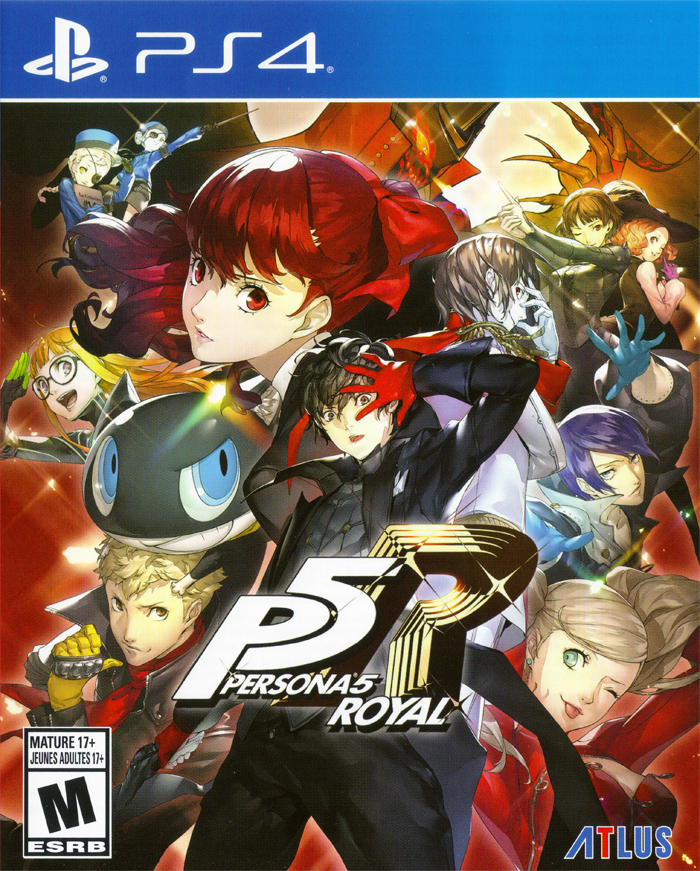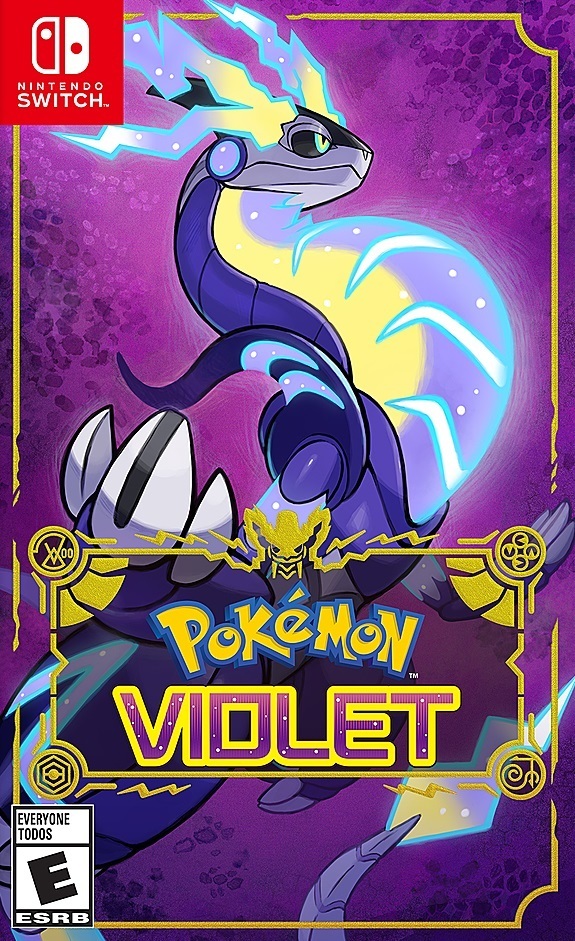Persona 5 Royal
Feb. 20th, 2023 11:49 am
The Blackboard Metaverse
Atlus's Persona videogame franchise began as a spinoff of their Megami Tensei series, the first few games of the subseries bearing the Shin Megami Tensei name and being mechanically different from mainline entries of the franchise. The first three games, the inaugural installment and both halves of the second entry, one of which wouldn't see an official English release until Sony released their PlayStation Portable system, first appeared on the PlayStation before transitioning to the PlayStation 2 with the third and fourth games, which bore much mechanical dissonance from its precursors, although in my opinion, said deviation was for the better. The fifth game, its latest incarnation titled Persona 5 Royal, builds upon its predecessors but brings a few old ideas back into the fray.
The latest Persona begins in the middle of its narrative, with the protagonist, leader of the Phantom Thieves and with the alias Joker, caught by Japanese authorities and interrogated, the action moving back to when he intervened in a situation earning him an assault charge and probation as he started life anew at a high school with other students assisting in his rehabilitation. Throughout the game are wrongdoers with metaversal Palaces where they play out their fantasies, the Phantom Thieves seeking to steal their symbolic Treasures along with the Hearts of the wrongdoers, in which case they confess their misdeeds.
Fans of the Kingdom Hearts series might roll their eyes at the similar concept of stealing hearts in the narrative, along with fans of the animanga Death Note who might or might not notice the supernatural methods of supernaturally reforming society by targeting certain deviants. However, Persona 5 delves into contemporary issues and themes that are somewhat relatable, such as abuse by teachers in school and the politics of Japan, with confidants Joker encounters and with whom he builds relationships having stories of their own, such as a washed-up ex-member of the Japanese Diet. However, the pacing is glacial and drawn-out, with the Royal version a bigger offender in that regard since its events go well beyond those of the initial release.
As with contemporary Persona localizations, the translation team opted to translate the dialogue with aspects unfriendly towards non-Japanophiles, with Japanese honorifics retained and accompanied by character names, which often breaks the naturality of the English localization, yet is still mercifully legible so long as players Google the internet to find out what they mean. However, like most English versions of Japanese RPGs, the writing is worst in combat, with the retained decision to have someone narrate everything that occurs in battle, and characters often shout "Persona!" when reaching their turns. Though generally a polished effort, the translation comes across as a middle-tier effort.
Like in the third and fourth Personas, alongside their various rereleases, Persona 5 features a methodical gameplay structure focused around the attendance of school by Joker and fellow students that eventually become his allies in combat. He has five social stats that increase with various activities like answering questions in school correctly, participating in diversions such as a batting cage and a bathhouse, and so forth, some of which need to be at certain levels for him to establish relationships with certain confidants that chiefly dictate how much bonus experience the player receives from fusing Personas of certain Arcanas, but there can be other effects such as the ability to score instant victories against enemy parties without needing to battle them.
Key to advancing the central storyline is the mentioned Palaces whose respective Treasures the player needs to steal to change the Hearts of the wretched individuals the Phantom Thieves target, enemies traversing these dungeons, players able to get preemptive strikes against them, but foes can do the same in return. Advancing one Arcana enough allows players to win instantly against enemy parties, with experience and money earned for living party members and a new Persona so long as Joker has the capacity for at least one more. Joker himself is the only character who can wield multiple Personas, his allies each having one with abilities, strengths, and weaknesses.
The general structure of combat is similar to the third and fourth mainline Personas, the player's party of four characters, headed by Joker, taking turns dependent upon agility, commands executed instantly upon input. During a turn, the player can get an indication of which unit will go next, but unlike Final Fantasy X, subsequent character/enemy order is indeterminate, yet mercifully doesn't break the game. Commands include attacking with an equipped melee weapon or firearm, using an SP-consuming ability from a Persona, guarding until their next turn, using an item, or attempting to escape, which may or may not work all the time.
As in the mentioned Personas and Megami Tensei series from which it branched, the ability of players and enemies to exploit one another's strengths and weaknesses adds strategy, the exploitation of one's weak point earning the exploiter another action. One difference from the third and fourth games, and a feature prevalent in the initial entry and both parts of the second, is the need to negotiate with downed enemies; luckily, the system isn't as open-ended as in the earlier Personas or up to random chance like in the mainline Megami Tensei games, demon personalities key to which answers to questions are correct.
Players can earn money, an item, or the alliance of one of the downed demons from a successful negotiation. The Velvet Room returns, where the player can fuse Personas to create more powerful (in some cases, weaker) ones, the facility indicating if they have had a demon before, and in my experience, I found it advantageous to fuse for new ones, since in whatever battles the player encounters said enemies in, they can outright skip negotiation when downing an enemy party. Consequentially, I only had to endure it less than a handful of times in the game's generous length. Players can also sacrifice Personas to obtain an item, including powerful equipment.
Victory nets players experience for occasional level-ups and money, a system paralleling the core mechanics being the Mementos dungeon, deeper levels opening depending on how popular the Phantom Thieves are with the Japanese public, and is similar to the Temple of the Ocean King from The Legend of Zelda: Phantom Hourglass, minus the need to redo puzzles (luckily absent in the metaversal region) and floors completely, with targets for occasional requests without the metaverse often found in certain levels. Aside from the minor issue with determining player and enemy turn order, the gameplay systems work well, and different difficulty levels accommodate players of varying skill levels.
Control is decent, the linear structure ensuring the player never becomes lost as to the current gameplay objective. However, while the Palaces have maps, the game doesn’t indicate which exits from floors lead where, which can lead to confusion. Most cutscenes are skippable along with the ability to cut spoken dialogue short if players wish to read instead of waiting for the performers to finish speaking, and the player can pause the action by bringing up a review of the latest text, similar to Valkyrie Profile: Lenneth. Fast travel also exists among points of interest in the real-life Japanese setting, saving significant time in a game that’s already long. There are some issues regarding the spacing of save opportunities, not to mention maybe a few annoying late-game puzzles, but otherwise, Persona 5 generally interfaces well with players.
Shoji Meguro provides the game music, which is generally enjoyable and features plenty of tracks that rarely get old, although there are occasional silent scenes. The sound effects are what one would expect from a contemporary RPG, and the voice acting is decent; there are, however, plenty of overlapping voice clips in battle and unnecessary narration of trivial things that occur then.
The art direction is generally superb, with a style one could describe as trippy, given the effective use of reddish colors, transitional sequences when one fast-travels between points of interest, enemy designs with no reskins, fluid animation, flashy combat effects, and nice cel-shading. However, the visuals contain some jaggies, along with textures that appear blurry and pixilated when seen close-up, and the view distance of NPCs can be poor.
Finally, Persona 5 Royal is incredibly long for a rigidly-linear game, a little over a hundred hours, around a dozen or so longer than the original release, and while there is some lasting appeal in the form of things such as Trophies, the length and limited potential for variation somewhat drag it down, most players likely wishing to move on to other games after completion.
Overall, Persona 5 Royal is a great rerelease of a game that was already good, given its superb gameplay mechanics and control, endearing narrative and characters, and solid audiovisual presentation. Granted, it often puts quantity above quality, and I found myself fast-forwarding through late-game dialogue given the game's unwillingness to end; there are also other issues like the translation's unfriendliness towards non-Japanophiles and mainstream gaming audiences in general. Regardless, those who haven't experienced the initial release will get a bang for their gaming buck with Royal, still superior to earlier games in the Persona series and the Megami Tensei franchise from which the subseries spun off.
The reviewer played a borrowed physical copy of the game to the ending credits.| Score Breakdown | |
|---|---|
| The Good | The Bad |
|
|
| The Bottom Line | |
| A great rerelease. | |
| Platform | PlayStation 4 |
| Game Mechanics | 9.5/10 |
| Control | 9.0/10 |
| Story | 8.5/10 |
| Localization | 8.0/10 |
| Aurals | 8.5/10 |
| Visuals | 8.5/10 |
| Lasting Appeal | 7.5/10 |
| Difficulty | Adjustable |
| Playtime | 72-96 Hours |
| Overall: 8.5/10 | |

